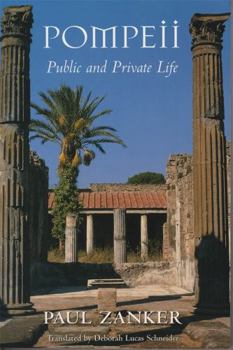Pompeii: Public and Private Life
(Part of the Revealing Antiquity Series)
Select Format
Select Condition 
Book Overview
Pompeii's tragedy is our windfall: an ancient city fully preserved, its urban design and domestic styles speaking across the ages. This richly illustrated book conducts us through the captured wonders of Pompeii, evoking at every turn the life of the city as it was 2,000 years ago. When Vesuvius erupted in 79 A.D. its lava preserved not only the Pompeii of that time but a palimpsest of the city's history, visible traces of the different societies...
Format:Paperback
Language:English
ISBN:0674689674
ISBN13:9780674689671
Release Date:January 1999
Publisher:Harvard University Press
Length:286 Pages
Weight:1.10 lbs.
Dimensions:0.6" x 5.8" x 8.5"
Customer Reviews
4 ratings
Excellent book
Published by Thriftbooks.com User , 19 years ago
This is about as fine a book as you will find on this subject. I enjoyed reading it immensely. Out of respect for the author's hard and dedicated work I encourage you to vote the jackass one-star review below by "Jeromiah Cox" as "Inappropriate" so that it can be removed.
Private Houses in Pompeii
Published by Thriftbooks.com User , 19 years ago
This book is an excellent introduction to Pompeii studies. Paul Zanker expertly describes the beginnings and variations on the private houses in Pompeii; how they were influenced by lavish country villas and how many of the houses were changed to provide an illusion of luxury. The "illusion" comes into play because many of the houses had very limited space and made the best of what they had. Several of the homes, such as the House of the Grand Duke, were not known to me. Mr. Zanker begins by relating the beginnings of Pompeii as an Oscan city and traces its development through the Social War, when Sulla settled veterans in the city, and into the Augustan period. The latter was arguably the golden age of Pompeii when the emperor took an interest in the city (by having an imperial aqueduct diverted to the city) and was a period of great civic building. The author provides a glimpse into some of the current theories about the city, such as did the wealthy leave Pompeii following the earthquake of 62? This is a theory that could use a chapter on its own and gets a page of discussion here. Another interesting discussion has to do with the reconstruction following the earthquake in 62 CE. Why were buildings like the basilica, and other civic buildings, left in ruins? One possibility is that buildings were rebuilt because there were fraternal groups that needed the use of the buildings (like the worshipers of Isis). Buildings like the amphitheater were repaired but the theaters were not. So this is a good introduction to the private homes of Pompeii: a book that can be read and followed up by more in depth reading. It is a fascinating look at the public and private sides of the city, illustrated nicely, and well written. Highly recommended.
Pompeiian textbook
Published by Thriftbooks.com User , 20 years ago
Zander's Pompeii is one of the main textbook books on Pompeii these days. She covers the city from an archaeologist's point of view by discussing the public and private areas of the city and how Pompeiians would have used them. She discusses not only how each of these areas were populated by regular Pompeiians, but also the women's and slaves' roles throughout the city through these private and public areas. This book is filled with good information for students, teachers and the amateur classicist alike. A must have for anyone interested in Pompeii or ancient Roman culture.
Zanker on Pompeii
Published by Thriftbooks.com User , 23 years ago
This book is with out a doubt an wonderful souce for students and Pompeii fanatics. As a classist myself, I was enraptured by this book. Zanker is able to intergrate the archaeological evidence with a comperhensive look at the pompeian socity. This is not to be missed!!





